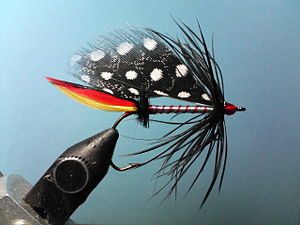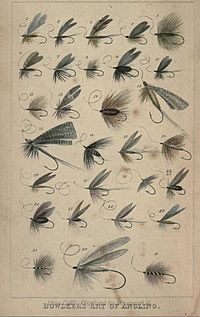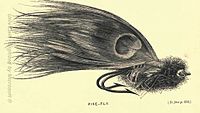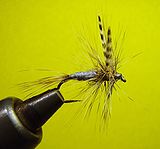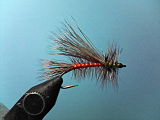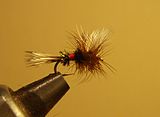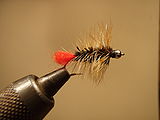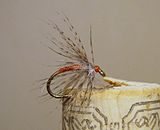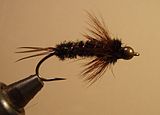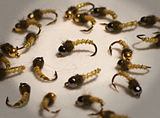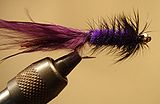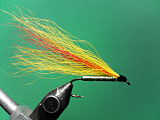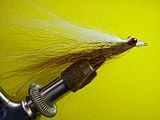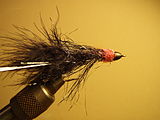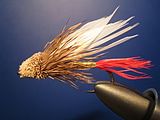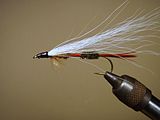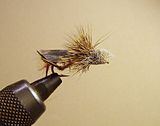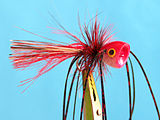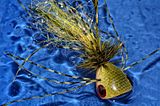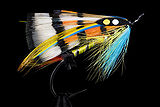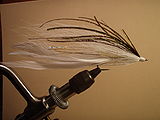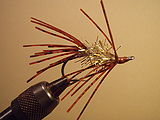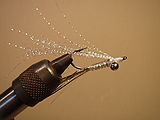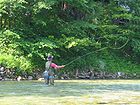- Artificial fly
-
An artificial fly or fly lure is a type of fishing lure, usually used in the sport of fly fishing (although they may also be used in other forms of angling). In general, artificial flies are the bait which fly fishers present to their target species of fish while fly fishing. Artificial flies are constructed by fly tying, in which furs, feathers, thread or any of very many other materials are tied onto a fish hook.[1] Artificial flies may be constructed to represent all manner of potential freshwater and saltwater fish prey to include aquatic and terrestrial insects, crustaceans, worms, baitfish, vegetation, flesh, spawn, small reptiles, amphibians, mammals and birds, etc. Effective artificial fly patterns are said to be killing flies because of their ability to put fish in the creel for the fly fisher. There are thousands of artificial fly patterns, many of them with descriptive and often idiosyncratic names.
Construction
Fly tying is a common practice in fly fishing, considered by many anglers an important part of the fly fishing experience. Many fly fishers tie their own flies, either following patterns in books, natural insect examples, or using their own imagination. The technique involves attaching small pieces of feathers, animal fur, and other materials on a hook in order to make it attractive to fish. This is made by wrapping thread tightly around the hook and tying on the desired materials. A fly is sized according to the width of the hook gap; large or longer flies are tied on larger, thicker, and longer hooks.
Types
Generally, fly patterns are considered either "imitations" or "attractors". Imitations seek to deceive fish through the life-like imitation of insects on which the fish may feed. Imitators do not always have to be precisely realistic in appearance; they may derive their lifelike qualities when their fur or feathers are immersed in water and allowed to move in the current. Attractors, which are often brightly colored, seek to draw a strike by arousing an aggression response in the fish. Famous attractors are the Stimulator, Royal Wulff, and Green Weenie flies.
History
The first literary reference to flies and fishing with flies was in Ælian’s Natural History probably written about 200 A.D. That work discussed a Macedonian fly. The Treatyse on Fysshynge with an Angle was published (1496) within The Boke of St. Albans attributed to Dame Juliana Berners. The book contains, along with instructions on rod, line and hook making, dressings for different flies to use at different times of the year. Probably the first use of the term Artificial fly came in Izaac Walton's The Compleat Angler (1653),[4]
Oh my good Master, this morning walk has been spent to my great pleasure and wonder: but I pray, when shall I have your direction how to make Artificial flyes, like to those that the Trout loves best?[5]
Frontpiece from Bowlker's Art of Angling (1854) showing a variety of artificial flies[6]
The 1652 4th. edition of John Dennys's The Secrets of Angling , first published in 1613, contains the first known illustration of an artificial fly.
By the early 19th century, the term artificial fly was being routinely used in angling literature much like this representative quote from Thomas Best's A Concise Treatise on the Art of Angling (1807) to refer to all types of flies used by fly fishers.
The art of artificial fly-fishing, certainly has the pre-eminence over the other various methods that are used to take fishes in the art of angling[7]
Although the term fly was a reference to an imitation of some flying insect, by the mid-19th century the term fly was being applied to a far greater range of imitation.[original research?]
The term fly is applied by sea fishermen to a certain arrangement of feathers, wax, etc., which I am about to describe the manufacture of, and which may be used with considerable success in mackerel, basse, and pollack fishing. I am not disposed to think, however, that such baits are ever mistaken by the fish which they are intended to capture for flies; but the number used, the way in which they are mounted, viz., several on one trace, and the method of their progress through the water, rather leads me to the belief that they are mistaken for a number of small fry, and treated accordingly.[8]
Imitation
Illustration of a large Pike fly (1865)[9]
A major concept in the sport of fly fishing is that the fly imitates some form of fish prey when presented to the fish by the angler. As aquatic insects such as Mayflies, Caddisflies and Stoneflies were the primary prey being imitated during the early developmental years of fly fishing, there were always differing schools of thought on how closely a fly needed to imitate the fish's prey.
In the mid to late 19th century, those schools of thought, at least for trout fishing were: the formalists (imitation matters) and the colourists (color matters most).[10] Today, some flies are called attractor patterns because in theory, they do not resemble any specific prey, but instead attract strikes from fish. For instance, Charles Jardine, in his 2008 book "Flies, Ties and Techniques," speaks of imitators and attractors, categorizing the Royal Wulff as an attractor and the Elk Hair Caddis as an imitator, whereas "... in sea trout and steelhead fishing there is a combination of imitation and attraction involved in fly construction".[11] Paul Schullery in American Fly Fishing - A History (1996) explains however that although much has been written about the imitation theories of fly design, all successful fly patterns must imitate something to the fish, and even a perfect imitation attracts strikes from fish. The huge range of fly patterns documented today for all sorts of target species-trout, salmon, bass and panfish, pike, saltwater, tropical exotics, etc. are not easily categorized as merely imitative, attractors or something else.[12]
Contemporary fly types and illustrative examples
The categorization of artificial flies has evolved considerably in the last 200 years as writers, fly tiers and fishing equipment retailers expound and promote new ideas and techniques. Additionally, as the popularity of fly fishing expanded globally to new and exotic target species, new flies and genera of flies came into being. There are many subtypes in some of these categories especially as they apply to trout flies. As well, any given pattern of artificial fly might well fit into multiple categories depending on its intended use. The following categorization with illustrative examples is derived from the following major artificial fly merchants offerings.
- Orvis - An American Fly Fishing Retailer in business since 1856 [13]
- Farlows of London - A British Fly Fishing Retailer in business since 1840[14]
- Umpqua Feather Merchants - An American artificial fly manufacturer and wholesaler in business since 1972[15]
Dry flies
Dry flies are designed to be buoyant, or to float on the surface of the water. Dry flies typically represent the adult form of an aquatic or terrestrial insect. Dry flies are generally considered freshwater flies.[16]
Dry flies The Adams - A typical dry flyOrange Stimulator - A caddisfly or grasshopper imitationRoyal Wulff - A classic attractor patternBlue Wing Olive Dry FlyWet flies
Wet flies are designed to sink below the surface of the water. Wet flies have been tied in a wide variety of patterns to represent larva, nymphs, pupa, drowned insects, baitfish and other underwater prey. Wet flies are generally considered freshwater flies.[17]
Wet flies Grizzly King - A classic wet flyA Woolly Worm wet flyProfessor wet flyPartridge and Orange soft-hackleNymph flies
Nymphs are designed to resemble the immature form of aquatic insects and small crustaceans. Nymph flies are generally considered freshwater flies.[18]
Nymphs Brook's Montana Stonefly nymphBiot midge larveEmerger flies
Emergers are designed to resemble the not quite mature hatching aquatic insect as it leaving the water to become an adult insect. Emerger flies are generally considered freshwater trout flies.[19]
Streamer flies
Streamers are designed to resemble some form of baitfish or other large aquatic prey. Streamer flies may be patterned after both freshwater and saltwater prey species. Streamer flies are a very large and diverse category of flies as streamers are effective for almost any type of gamefish.[20]
Streamer flies Woolly Bugger - A universal streamer patternMickey Finn - A classic streamer patternClouser Deep Minnow - A popular streamer pattern used for both fresh and saltwater fishingBlack Conehead Egg Sucking LeechMuddler Minnow - a sculpin imitationSchenk's White Minnow - A popular eastern chub imitationRoyal Coachman BucktailArticulated streamerTerrestrial flies
Terrestrials are designed to resemble non-aquatic insects, crustaceans and worms that could fall prey to feeding fish after being blown or falling onto the water.,[21][22]
Terrestrial flies Dave's Hopper, a terrestrial dry fly imitating a common grasshopperBass and panfish flies, bugs and poppers
Bass and panfish flies, bugs and poppers are generally designed to resemble both surface and sub-surface insect, crustacean, baitfish prey consumed by warm-water species such as Largemouth bass or bluegill. This genus of flies generally includes patterns that resemble small mammals, birds, amphibians or reptiles that may fall prey to fish, or in the case of panfish flies, small aquatic insects or crustaceans.
Bass and panfish flies Red Bass popperBass popper on waterBluegill streamer EP stylePike and musky flies
Pike and musky flies are generally designed to resemble both surface and sub-surface crustacean, baitfish prey consumed by species of the genus Esox such as Northern Pike or Muskellunge. This genus of flies are larger than bass flies and generally includes patterns that resemble baitfish and small mammals, birds, amphibians or reptiles that may fall prey to fish.[23]
Carp flies
Carp flies are designed to resemble various vegetative sources of food that carp feed on such as berries, seeds and flowers that may fall into the water.[24]
Salmon flies
Salmon flies are a traditional class of flies tied specifically to fly fish for Atlantic Salmon. Some salmon flies may be classified as lures while others may be classified as dry flies, such as the bomber. Salmon flies are also tied in classic and contemporary patterns.[25]
Salmon flies Durham Ranger - a Classic Salmon flyGreen Highlander - a Classic Salmon flySteelhead and Pacific salmon flies
Steelhead and Pacific salmon flies are designed for catching anadromous steelhead trout and pacific salmon in western North American and Great Lakes rivers.
Egg flies
Egg flies are all designed to resemble the spawn of other fish that may be encountered in a river and consumed by the target species.
Flesh flies
Flesh flies are designed to resemble the rotting flesh of pacific salmon encountered in a river and consumed by the target species.
Saltwater flies
Saltwater flies are a class of flies designed to represent a wide variety of inshore, offshore and estuarial saltwater baitfish, crustacean and other saltwater prey. Saltwater flies generally are found in both sub-surface and surface patterns.[26]
Saltwater flies White Lefty's Deceiver - An all purpose saltwater baitfish imitationGold bendback shrimp flyCockroach Deceiver (Lefty Kreh)Bonefish flies
Bonefish flies are a special class of saltwater flies used to catch Bonefish in shallow water. Bonefish flies generally resemble small crabs, shrimp or other crustaceans.[27]
Bonefish flies Crazy Charlie - A popular bonefish flyBonefish shrimp flyTarpon flies
Tarpon flies are a special class of saltwater flies used to catch Tarpon in both inshore and offshore waters. Tarpon flies generally represent small baitfish commonly preyed upon by tarpon.[27]
Tarpon flies Stu Apte Classic Tarpon FlyStriped bass flies
Striped bass flies are a special class of freshwater-saltwater fly used to catch Striped Bass in freshwater, inshore and offshore waters. Striped bass flies generally represent small baitfish commonly preyed upon by striped bass.
See also
Bibliography of fly fishing
Notes
- ^ Wakeford, Jacqueline (1992). Fly Tying Tools and Materials. New York: Lyons & Burford Publishers. pp. Preface. ISBN 1558211837.
- ^ Dennys, John. The Secrets of Angling (4th. Ed., 1652). London: Robert Triphook. pp. 20.
- ^ Leonard, J. Edson (1950). Flies-Their origin, natural history, tying, hooks, patterns and selections of dry and wet flies, nymphs, streamers, salmon flies for fresh and salt water in North America and the British Isles, including a Dictionary of 2200 Patterns. New York: A.S. Barnes and Company. pp. 33.
- ^ Hills, John Waller (1921). A History of Fly Fishing for Trout. London: Phillp Allan & Co.
- ^ The Compleat Angler (1653)
- ^ Bowlker (1854). Art of Angling-Containing Directions for Fly-Fishing, Trolling, Making Artificial Flies, etc.. London. pp. frontpiece.
- ^ Best, Thomas (1807). A Concise Treatise on the Art of Angling. London: B. Crosby and Co.. pp. 93.
- ^ Lord, W. B. (1863). Sea Fish and How To Catch Them. London: Bradbury and Evans.
- ^ Pennell, H. Cholmondeley (1865). The Book of Pike. London: Frederick Warne and Co. p. 232.
- ^ Pennell, H. Cholomondeley (1884). The Modern Practical Angler. London: George Routledge and Sons. pp. 65–78.
- ^ Jardine, Charles, Flies, Ties, and Techniques, Ivy Press, East Sussex, p. 6,p. 56,p.60, 2008
- ^ Schullery, Paul (1996). American Fly Fishing-A History. Norwalk, CT: The Easton Press. pp. 85–99, 228–234..
- ^ Orvis Online Fly Catalog
- ^ Farlows of Pall Mall Website
- ^ Umpqua Feather Merchants Fly Gallery
- ^ Hughes, Dave (1999). "Searching Dry Flies". Trout Flies-The Tier's Reference. Mechanicsburg, PA: Stackpole Books. pp. 46–85. ISBN 9780811716017.
- ^ Hughes, Dave (1995). Wet Flies: Tying and Fishing Soft-Hackles, Winged and Wingless Wets, and Fuzzy Nymphs. Mechanicsburg, PA: Stackpole Books. ISBN 0811718689.
- ^ Schwiebert, Ernest (1973). Nymphs-A Complete Guide to Naturals and Imitations. New York: Winchester Press. ISBN 0876910746.
- ^ Hughes, Dave (1999). "Mayfly Emergers". Trout Flies-The Tier's Reference. Mechanicsburg, PA: Stackpole Books. pp. 170–186. ISBN 9780811716017.
- ^ Bates, Joseph D. (1966). Streamer Fly Tying & Fishing. Harrisburg, PA: Stackpole Books.
- ^ Hughes, Dave (1999). "Grasshoppers and Crickets". Trout Flies-The Tier's Reference. Mechanicsburg, PA: Stackpole Books. pp. 443–457. ISBN 9780811716017.
- ^ Steeves, Harrison R.; Koch, Ed (1994). Terrestrials-A Modern Approach to Fishing and Tying with Synthetic and Natural Materials. Mechanicsburg, PA: Stackpole Books. ISBN 081170629X.
- ^ Reynolds, Barry; Berryman, John (1993). Pike on the Fly-The Fly Fishing Guide To Northerns, Tigers, and Muskies. Boulder, CO: Johnson Printing Company. ISBN 1555661130.
- ^ Reynolds, Barry; Befus, Brad; Berryman, John (1997). Carp on the Fly: A Flyfishing Guide. Spring Creek Press. ISBN 1555662072.
- ^ Bates, Joseph D. (1970). Atlantic Salmon Flies and Fishing. Harrisburg, PA: Stackpole Books. ISBN 0811701808.
- ^ Richards, Carl (1995). Prey: Designing and Tying New Imitations of Fresh and Saltwater Forage Foods. New York: Lyons and Burford Publishers. ISBN 1558213325.
- ^ a b Kreh, Lefty (1992). Fly Fishing for Bonefish, Permit & Tarpon. Birmingham, Alabama: Odysseus Editions.
Further reading
- Bowlker (1854). Art of Angling-Containing Directions for Fly-Fishing, Trolling, Making Artificial Flies, etc.. London.
- Halford, Frederic M. (1886). Floating Flies and How to Dress Them. A Treatise on the Most Modern Methods of Dressing Artificial Flies for Trout and Grayling with Full Illustrated Directions and Containing Ninety Hand-Coloured Engravings of the Most Killing Patterns Together with a Few Hints to Dry-Fly Fishermen.. London: Sampson, Low, Marston, Searle, and Rivington.
- Ogden, James (1887). Ogden on Fly Tying, Etc. London: Sampson Low, Marston, Searle & Rivington.
- Shipley, M.A. (1888). Artificial Flies and How To Tie Them. Philadelphia, PA: Press of Spangler and Davis.
- Marbury, Mary Orvis (1892). Favorite Flies and Their Histories. Boston and New York: Houghton and Mifflin Company.
- Hale, Captain John Henry (1892). How to Tie Salmon Flies. London: Samson, Low and Marston Company Ltd.
- La Branche, George M. L. (1914). The Dry Fly and Fast Water. New York: Charles Scribner's and Sons.
- Rhead, Louis (1916). American Trout Stream Insects-A Guide To Angling Flies and other Aquatic Insects Alluring to Trout. New York: Frederick A. Stokes Company Publishers.
- McClelland, H. G. (1919). The Trout Fly Dresser's Cabinet of Devices or How To Tie Flies for Trout and Grayling Fishing. London: The Fishing Gazette.
- Hills, John Waller (1921). A History of Fly Fishing for Trout. London: Phillp Allan & Co.
- Skues, G.E.M. (1921). The Way of a Trout with the Fly: And some further studies in minor tactics. London: Adams and Charles Black.
- Jennings, Preston J. (1935). A Book of Trout Flies. New York: Crown Publishers, Derrydale Press.
- Brooks, Joe (1947). Bass Bug Fishing. South Brunswick, NJ: A. S. Barnes.
- Leonard, J. Edson (1950). Flies-Their origin, natural history, tying, hooks, patterns and selections of dry and wet flies, nymphs, streamers, salmon flies for fresh and salt water in North America and the British Isles, including a Dictionary of 2200 Patterns. New York: A.S. Barnes and Company.
- Schwiebert, Ernest G. Jr. (1955). Matching The Hatch-A Practical Guide to Imitation of Insects Found On Eastern and Western Trout Waters. Toronto, Canada: The MacMillan Company.
- Bates, Joseph D. (1966). Streamer Fly Tying & Fishing. Harrisburg, PA: Stackpole Books.
- Bates, Joseph D. (1970). Atlantic Salmon Flies and Fishing. Harrisburg, PA: Stackpole Books. ISBN 0811701808.
- Richards, Carl; Swisher, Doug (1971). Selective Trout-A Dramatically New and Scientific Approach to Trout Fishing on Eastern and Western Rivers. New York: Crown Publishers.
- Schwiebert, Ernest (1973). Nymphs-A Complete Guide to Naturals and Imitations. New York: Winchester Press. ISBN 0876910746.
- Kreh, Lefty (1974). Fly Fishing in Saltwater. New York: Crown Publishers Inc.
- Combs, Trey (1976). Steelhead Fly Fishing and Flies. Portland, Oregon: Frank Amato. ISBN 093660803X.
- Kreh, Lefty (1992). Fly Fishing for Bonefish, Permit & Tarpon. Birmingham, Alabama: Odysseus Editions.
- Reynolds, Barry; Berryman, John (1993). Pike on the Fly-The Fly Fishing Guide To Northerns, Tigers, and Muskies. Boulder, CO: Johnson Printing Company. ISBN 1555661130.
- Kreh, Lefty (1993). Professionals' Favorite Flies-Volume 1-Dry Flies, Emergers, Nymphs & Terrestials. Birmingham, Alabama: Odysseus Editions.
- Kreh, Lefty (1994). Professionals' Favorite Flies-Volume 2-Streamers, Poppers, Crustaceans and Saltwater Patterns. Birmingham, Alabama: Odysseus Editions.
- Greenhalgh, Malcolm (2009). Fishing Flies: A World Encyclopedia of Every Type of Fly. London, UK: HarperCollins. ISBN 9780007288458. http://www.FishingFliesEncyclopedia.com.
- Steeves, Harrison R.; Koch, Ed (1994). Terrestrials-A Modern Approach to Fishing and Tying with Synthetic and Natural Materials. Mechanicsburg, PA: Stackpole Books. ISBN 081170629X.
- Law, Glenn (1995). A Concise History of Fly Fishing. Birmingham, Alabama: Odysseus Editions.
- Hughes, Dave (1995). Wet Flies: Tying and Fishing Soft-Hackles, Winged and Wingless Wets, and Fuzzy Nymphs. Mechanicsburg, PA: Stackpole Books. ISBN 0811718689.
- Richards, Carl (1995). Prey: Designing and Tying New Imitations of Fresh and Saltwater Forage Foods. New York: Lyons and Burford Publishers. ISBN 1558213325.
- Schullery, Paul (1996). American Fly Fishing-A History. Norwalk, CT: The Easton Press.
- Reynolds, Barry; Befus, Brad; Berryman, John (1997). Carp on the Fly: A Flyfishing Guide. Spring Creek Press. ISBN 1555662072.
- Hughes, Dave (1999). Trout Flies-The Tier's Reference. Mechanicsburg, PA: Stackpole Books. ISBN 9780811716017.
- Schullery, Paul (1999). Royal Coachman-The Lore and Legends of Fly-Fishing. New York: Simon and Schuster. ISBN 0684842467.
- Schullery, Paul (2006). The Rise-Streamside Observations on Trout, Flies and Fly Fishing. Mechanicsburg, PA: Stackpole Books. ISBN 9780811701822.
- Schullery, Paul (2006). Cowboy Trout-Western Fly Fishing As if it Matters. Montana Historical Society. ISBN 097215227X.
Fisheries and fishing topic areas Fisheries 
Fishing - Fisherman
- Artisan fishing
- Fishing villages
- Fishing vessels
- Fishing history
Industrial Recreational Techniques Tackle Locations - Fishing by country
- Fishing villages
- Fishing banks
- Fish ponds
- Marine habitats
- Index of fishing articles
- List of fishing topics by subject
- Fisheries glossary
Categories:
Wikimedia Foundation. 2010.

